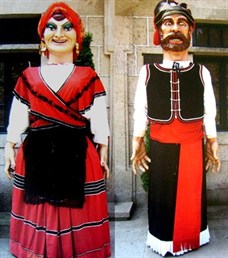The Giants of Redondela (Galicia)
 During the procession of Corpus Christi in Redondela (Galicia), a giant puppet depicting Saint Christopher marches. His participation in the sacred procession, attested only from the nineteenth century, may even date back to the sixteenth century. This hypothesis, supported by some evidence, is certainly plausible. Saint Christopher, in fact, together with the Philistine Goliath, was among the first processional giants manufactured in Europe. His appearance in processions of Corpus Christi, moreover, is testified to between the end of the Middle Ages and the Early Modern period. The nineteenth-century giant, four metres high and eighty kilos in weight, was made up of a structure made of wood covered with canvas. It is carried in procession with the aid of a litter held by four people. According to tradition, Saint Christopher of Redondela carried the the effigy of the Christ Child on his shoulder. As was the case with its Italian equivalent, the huge Galician figure has undergone numerous transformations, which have distorted both the outward form as its identity. Just as was the case with other European giants, in fact, at one point even the Saint Christopher of Redondela was joined by a female figure which was equally impressive. In the 1960s it even disappeared from the Corpus Christi procession. Rebuilt with lighter materials, in later years the saint has returned to participate in the procession of Redondela, flanked by giants, the characteristic cabezudos (huge heads worn by carriers) and, above all, by the legendary CocaTradition has it that the Tarasca is originally from Galicia, and even today during the procession of Corpus Christi in Redondela, a town in that Spanish autonomous community, a strange crocodile named Coca parades in a procession. It is said that the huge creature came out of its den to kidnap young women of the country until some sailors not killed it. Legend has it that since then the beast participates in the procession to symbolize the defeat of the demon. Today, this episode is celebrated with the characteristic Danza de las Espadas and the Baile de las Penlas.: a hybrid monster resembling a crocodile (Cocatrix, in Latin), similar in appearance to the Tarasca of Barcelona.
During the procession of Corpus Christi in Redondela (Galicia), a giant puppet depicting Saint Christopher marches. His participation in the sacred procession, attested only from the nineteenth century, may even date back to the sixteenth century. This hypothesis, supported by some evidence, is certainly plausible. Saint Christopher, in fact, together with the Philistine Goliath, was among the first processional giants manufactured in Europe. His appearance in processions of Corpus Christi, moreover, is testified to between the end of the Middle Ages and the Early Modern period. The nineteenth-century giant, four metres high and eighty kilos in weight, was made up of a structure made of wood covered with canvas. It is carried in procession with the aid of a litter held by four people. According to tradition, Saint Christopher of Redondela carried the the effigy of the Christ Child on his shoulder. As was the case with its Italian equivalent, the huge Galician figure has undergone numerous transformations, which have distorted both the outward form as its identity. Just as was the case with other European giants, in fact, at one point even the Saint Christopher of Redondela was joined by a female figure which was equally impressive. In the 1960s it even disappeared from the Corpus Christi procession. Rebuilt with lighter materials, in later years the saint has returned to participate in the procession of Redondela, flanked by giants, the characteristic cabezudos (huge heads worn by carriers) and, above all, by the legendary CocaTradition has it that the Tarasca is originally from Galicia, and even today during the procession of Corpus Christi in Redondela, a town in that Spanish autonomous community, a strange crocodile named Coca parades in a procession. It is said that the huge creature came out of its den to kidnap young women of the country until some sailors not killed it. Legend has it that since then the beast participates in the procession to symbolize the defeat of the demon. Today, this episode is celebrated with the characteristic Danza de las Espadas and the Baile de las Penlas.: a hybrid monster resembling a crocodile (Cocatrix, in Latin), similar in appearance to the Tarasca of Barcelona.
<<<—previous page back to index—>>>
